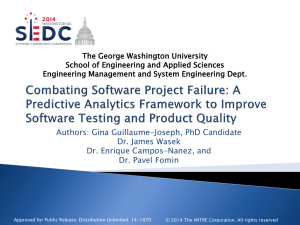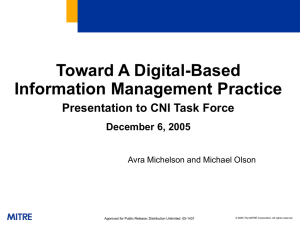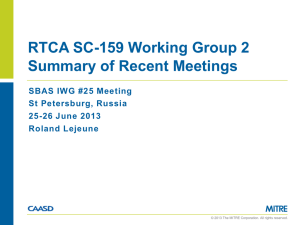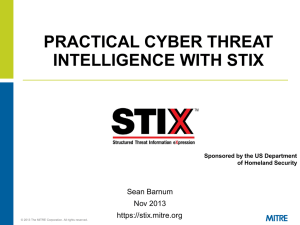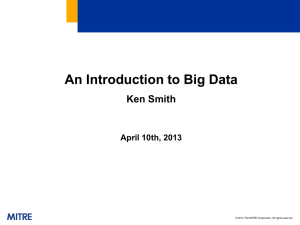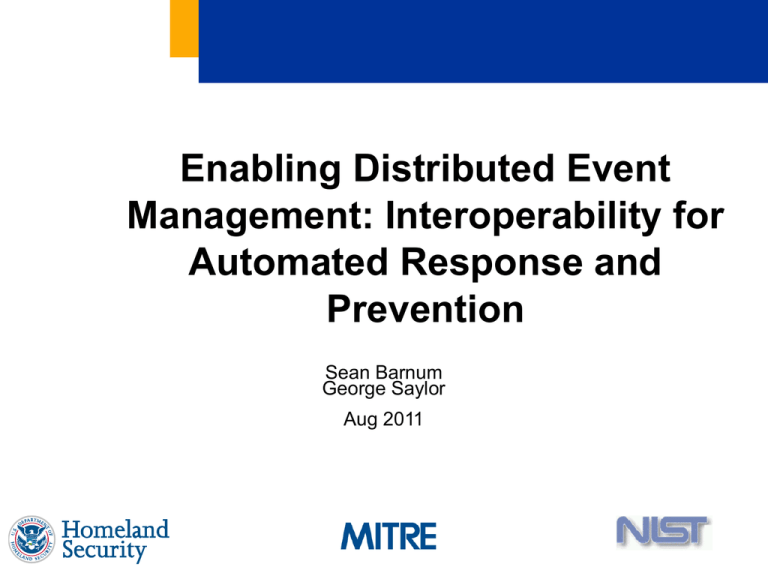
Enabling Distributed Event
Management: Interoperability for
Automated Response and
Prevention
Sean Barnum
George Saylor
Aug 2011
The HS SEDI FFRDC is managed and operated by The MITRE Corporation for DHS.
Premise
■ Supporting attack detection and automated courses of
action in today’s advanced threat environment requires
integration and correlation of diverse sets of event
producers as well as standardized structured event
representations to support interoperability
■ Solution Resources
– Event Management Automation Protocol (EMAP)
– Cyber Observable eXpression (CybOX)
3
The HS SEDI FFRDC is managed and operated by The MITRE Corporation for DHS.
The Problem
• Lots of events, all in different formats
The Problem (Continued)
What is EMAP?
• A program to establish a protocol to enable standardized
content, representation, exchange, correlation, searching,
storing, prioritization, and auditing of event records within an
organizational IT environment
• A specification to meet these goals and define how relevant
technical specifications will interact to achieve the desired
outcomes.
• Develop and implement validation of products that conform
to the standard
What is EMAP? (Continued)
Languages
Metrics
Express logs and
policies
Event scoring
framework
•
•
•
•
•
•
•
Common Log formats
Log correlation rules
Logging configuration
Audit Settings
Normalization
Incident Description
Observable Description
Enumerations
Convention for
identifying and naming
• Severity of logged events • Log taxonomy
• Criticality
• Enrichment information
• Impact
• Observables
(U)
Event Funnel
# of
events
millions
firewalls
intrusion
detection
antivirus/m
alware
enumerations
normalization
thousands
languages
correlation
hundreds
metrology
tens
prioritized
threats
vulnerability
scans
system/appl
ication
How it all works
PARSE
FILTER
CORRELATE
Notional EMAP Components
• Common Event Expression (CEE)
– A suite of specifications to define taxonomy,
syntax, transport, logging recommendations, and
parsing information about event records
• Open Event Expression Language (OEEL)
– A language to express parsing and normalization
logic using CEE Profiles to convert event records
into CEE
• Common Event Rule Expression (CERE)
– A common format to express rules for pattern
matching, filtering, and correlation
Notional EMAP Components
• Common Event Scoring System (CESS)
– A specification that provides metrics of event
severity and impact based on multiple factors
• Cyber Observable eXpression (CybOX)
– A language to express cyber observable events
or stateful measures that provides a common
foundation for many of the other standards
CEE Components
•
•
•
•
•
CEE Dictionary
CEE Taxonomy (CEET)
Common Event Log Recommendations (CELR)
Common Log Syntax (CLS)
Common Log Transport (CLT)
CEE Architecture
OEEL
• Provide a standardized ability to represent
parsing logic external to the parsing
application
– Provide vendors and consumers to express and
share parsing logic in a standard format
– Simplify product development
– A way to change a native log into a standard
format (example Apache to CEE)
– Combine multiple log and data sources together
into common output
CERE
• Provide vendors and consumers a way to
express and share rules for pattern matching,
correlation, and filtering of logs
– Support distributed multi-vendor enterprises
– Aid in acquisition
– Simplify sharing detection rules to public
– Achieve this with minimal impact to vendors and
consumers
CESS
• Provide a metric for scoring the severity,
criticality, and impact of a given event, set of
events, or incident
– Leverage EMAP components to derive reasonably
accurate scoring
– Use CESS to assist in filtering and correlation
– Provide vendors, responders, analysts a reliable
and repeatable means of calculating and sharing
this information
Enabling Automated Response and
Prevention
• Interoperability
– Mapping observables and indicators to detection
rules
– Mapping attack patterns to observables and
detection rules
– Mapping malware characteristics to observables
and rules
– Incident Management automation through
information exchange of standardized content
Cyber Observables Overview
■ The Cyber Observables construct is intended to capture
and characterize events or properties that are observable in
the operational domain.
■ These observable events or properties can be defined in
rules or used to adorn the appropriate portions of the attack
patterns in order to tie the logical pattern constructs to realworld evidence of their occurrence or presence for attack
detection and characterization.
■ By capturing them in a structured fashion, the intent is to
enable future potential for detailed automatable mapping
and analysis heuristics.
UNCLASSIFIED
© 2010 The MITRE Corporation. All rights reserved.
■Cyber observables apply to numerous
domains
– Detailed attack patterns
– Malware characterization
– Operational Events
– Logging
– Cyber situational awareness
– Incident response
– Forensics
– Etc.
UNCLASSIFIED
© 2010 The MITRE Corporation. All rights reserved.
A Brief History of Cyber Observables
■ September 2009: Concept introduced to CAPEC in Version 1.4 as
future envisioned adornment to the structured Attack Execution
Flow
■ June 2010: Broader relevance to MSM recognized leading to
CAPEC, MAEC & CEE teams collaborating to define one common
structure to serve the common needs
■ August 2010: Discussed with US-CERT at GFIRST 2010
■ December 2010: Cyber Observables schema draft v0.4 completed
■ December 2010: Discussions with Mandiant for collaboration and
alignment between Cyber Observables and Mandiant OpenIOC
■ January 2011: Discussed & briefed with MITRE CSOC
■ February 2011: Discussed & briefed with NIST – EMAP and USCERT who also have a need for this construct and had begun to
work on parallel solutions
■ May 2011: Schematic alignment and integration with CEE
UNCLASSIFIED
© 2010 The MITRE Corporation. All rights reserved.
Common Cyber Observables (CybOX)
Schema
File System
GUI
IPC
Internet
Defined Object
Module
Object State
Measure Source
Registry
Stateful_Measure
Observable
Object
Custom Attributes
Measure
Memory
Event
Action
Network
Daemon
Page 21
UNCLASSIFIED
© 2010 The MITRE Corporation. All rights reserved.
Common Cyber Observables (CybOX)
Schema
File System
GUI
IPC
Internet
Defined Object
Module
Object State
Measure Source
Registry
Stateful_Measure
Observable
Object
Custom Attributes
Measure
Memory
Event
Action
Network
Daemon
Page 22
UNCLASSIFIED
© 2010 The MITRE Corporation. All rights reserved.
Common Cyber Observables (CybOX)
Schema
File System
GUI
IPC
Internet
Defined Object
Module
Object State
Measure Source
Registry
Stateful_Measure
Observable
Object
Custom Attributes
Measure
Memory
Event
Action
Network
Daemon
Page 23
UNCLASSIFIED
© 2010 The MITRE Corporation. All rights reserved.
Various Defined Object Schemas
■ Account
■ Service
■ Win Named Pipe
■ Disk
■ Socket
■ Win Network Route
■ Disk Partition
■ System
■ Win Prefetch
■ DNS Cache
■ User Session
■ Win Registry
■ Email Message
■ Volume
■ Win Semaphore
■ File
■ Win Critical Section
■ Win System Restore
■ GUI
■ Win Driver
■ Win Task
■ Library
■ Win Event
■ Win Thread
■ Package
■ Win Event Log
■ Win Waitable Timer
■ Memory
■ Win Kernel
■ X509 Certificate
■ Network Connection ■ Win Kernel Hook
■ Win Handle
■ Network Route
■ Linux Package
■ Win Mailslot
■ Product
■ Win Mutex
…
(more on the way)
Page 24
UNCLASSIFIED
© 2010 The MITRE Corporation. All rights reserved.
UNCLASSIFIED
© 2010 The MITRE Corporation. All rights reserved.
Cyber Observable Use Cases
■ Potential ability to analyze data from all types of tools and
all vendors
■ Improved sharing among all cyber observable stakeholders
■ Detect malicious activity from attack patterns
■ Empower & guide incident management
■ Identify new attack patterns
■ Prioritize existing attack patterns based on tactical reality
■ Ability to metatag cyber observables for implicit sharing
controls
■ Enable automated signature rule generation
■ Enable new levels of meta-analysis on operational cyber
observables
■ Potential ability to automatically apply mitigations specified
in attack patterns
■ Etc….
UNCLASSIFIED
© 2010 The MITRE Corporation. All rights reserved.
Use Case: Detect Malicious Activity
■ Current:
– Manual effort to pull together data across many sensors
■
Results in limited situational awareness
– Attack patterns and rules are typically too detailed (physical
signatures) or ambiguous prose
– High level of effort
– High false negatives & positives
■ CybOX-enabled:
– Diverse set of sensors output data in common format
– Attack patterns and rules can be defined in a uniform fashion
– Pattern matching and analysis heuristics can be easily
automated
UNCLASSIFIED
© 2010 The MITRE Corporation. All rights reserved.
Use Case: Incident Response Data Capture
■ Current:
– Very manual
– Inconsistent between analysts & organizations
– Prose-based and imprecise
– Difficult to automate capture and actionable alerts
■ CybOX-enabled:
– Improved consistency
– Ability to tie everything together
– Simplified and automated data capture
– Alerts become actionable for automation
UNCLASSIFIED
© 2010 The MITRE Corporation. All rights reserved.
Use Case: Malware Analysis
■ Current:
– Difficult to combine different analysis perspectives or tools
– Difficult to share info
– Difficult to recognize if malware has been seen before
– Does not scale well
■ CybOX(MAEC)-enabled:
– Easier to integrate different forms of analysis, different tools
and even information from different sources
– Easier to share information
– Easier to recognize malware (including variants and
pertubations)
– Enables automated interaction among the various dimensions
of malware analysis
UNCLASSIFIED
© 2010 The MITRE Corporation. All rights reserved.
Use Case: Malware Artifact Hunting
■ Current:
– Very manual
– Often imprecise and inconsistent
– Localized
■ CybOX(MAEC)-enabled:
– Very automated
– Consistent
– Enables broad, non-localized sharing and hunting
UNCLASSIFIED
© 2010 The MITRE Corporation. All rights reserved.
Use Case: Host Based Detection
Dynamic Analysis
Engine
•Anubis
•CWSandbox
Engine
Output
•ThreatExpert
•Etc.
Malware
Binary
Sandbox -> MAEC Translator
Host-based Scanner
© 2011 The MITRE Corporation. All rights reserved.
Use Case: IR/IM Alerts
■ Current:
– Typically unstructured prose
– Labor intensive and slow
– Limited actionable (in an automated fashion) data
■ CybOX-enabled:
– Structured and consistent
– Alert generation can be much faster and less labor intensive
– Potentially actionable in an automated context
UNCLASSIFIED
© 2010 The MITRE Corporation. All rights reserved.
Notional Flow of a Modern Security Incident
1. An attack on an information system occurs involving social
engineering, vulnerability exploit, malware + command and
control (C2).
2. CybOX-enabled operational sensors (IDS, host-based, etc.) pick
up anomalous activity and report it in CEE/CybOX formats.
3. Automated analysis tools & rules attempt to match anomalous
activity against CybOX-adorned CAPEC attack patterns but
discover no matching patterns.
4. Incident is reported – Incident Response/Management process is
initiated.
5. IR personnel capture discovered detail of incident in CybOXcompliant formats, including CEE.
6. IR personnel detect malware as part of the ongoing attack.
UNCLASSIFIED
© 2010 The MITRE Corporation. All rights reserved.
Notional Flow of a Modern Security Incident (cont.)
7. Malware undergoes automated analysis (dynamic and/or static)
and results are captured in MAEC (CybOX-integrated) language.
8. Malware analysts are able to correlate the current malware
instance with a broad range of pre-existing malware samples and
analysis data from MAEC-enabled repositories and zoos.
9. Malware analysts capture new discovered detail of the malware in
MAEC format, including the CWE or CVE exploited .
10.Sample and analysis data from current malware instance are
entered into appropriate malware repositories and zoos.
11.CybOX observables of malware effects on hosts are extracted
from MAEC content to generate OVAL checks to determine if any
given host has been infected/affected by the current malware
instance.
12.OVAL checks are distributed and run against other areas of the
domain or enterprise to determine breadth of compromise.
UNCLASSIFIED
© 2010 The MITRE Corporation. All rights reserved.
Notional Flow of a Modern Security Incident (cont.)
13. IR/IM personnel apply appropriate mitigations/remediations to
negate the effects of the attack.
14.A new CAPEC attack pattern is authored to describe this new
observed attack behavior, and is adorned as appropriate with
CybOX content observed for this pattern in the operational space.
15.IR/IM personnel issue relevant alerts for the observed incident
including the new CAPEC pattern, MAEC bundle and related
CEE/CybOX content.
16.Secure development takes advantage of this new CAPEC pattern to:
define/refine appropriate security policy, training & requirements;
guide security engineering (control selection), architectural risk
analysis, secure code review and security testing; identify relevant
CWE weaknesses, CVE vulnerabilities & CCE configuration issues;
prioritize relevant CAPEC patterns based on real-world observed
prevalence/frequency profiled through automated observation of
CybOX patterns in the operational space .
UNCLASSIFIED
© 2010 The MITRE Corporation. All rights reserved.
Where is CybOX today?
■ Currently integrated into CAPEC
■ Currently integrated into MAEC
■ In process of being integrated into CEE
■ Part of the strategic approach for EMAP
■ Part of the strategic vision for IR/IM with US-CERT
■ Continued integration discussions planned for
Mandiant OpenIOC once initial drafts of Object
schemas are complete
■ Currently being evaluated for integration into multiple
research projects
■ Website should be up soon
UNCLASSIFIED
© 2010 The MITRE Corporation. All rights reserved.
Questions / Comments?
Sean Barnum
sbarnum@mitre.org
George Saylor
george.saylor@nist.gov
EMAP Developer Days (Aug 29-30) – NIST
http://scap.nist.gov/events
ITSAC (Oct 31 - Nov 2) – Crystal City

